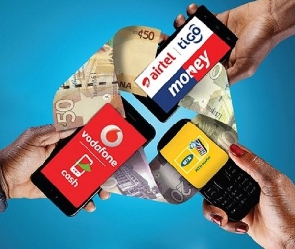After seven years of phenomenal growth as a payments platform in Ghana, the increase in mobile money (MoMo) users and usage has begun to slow giving indications that this transformational payment platform, in its current form, may be approaching maturity. Statistics released by the Bank of Ghana yesterday reveal that the number of registered MoMo accounts increased by just 5.16 percent over the 12 months period June 2018 to June 2019 from 29,988,590 to 31,536,680. This compares with a 36 percent increase in registered accounts over the 12 months between the end of 2017 and the end of 2018.
Indeed, the number of registered accounts as at June this year was actually lower than the 32,554,346 as at the end of 2018.
However, growth in both the total volume and total value of transactions remains strong, albeit slower than in previous years. The total number of MoMo transactions over the six months January to June 2019 was 915,795,074, up 39.81 percent on the 655,002,089 recorded during the corresponding period of 2018. But this growth was slower than the 48.2 percent growth in the number of transactions recorded for the whole of 2018, compared with the previous year.
Similarly, the total value of MoMo transactions recorded during the first half of 2019, at GHc140,180.65 million, was 34.01 percent higher than the GHc104,602.36 million recorded during the first six months of 2018. But this was also slower than the 43.2 percent growth recorded for the whole of 2018 as compared to the whole of the previous year.
The balance of MoMo on float by the middle of 2019, at GHc3,032.37 million was 38.94 percent higher than the balance of float 12 months earlier, of GHc2,182.57 million.
Instructively, the ratio of registered MoMo accounts to total mobile voice subscriptions has more or less stabilized, standing at 77 percent by June 2019, up only marginally from 76 percent as at June 2018; this ratio has grown from just 14.7 percent as at the end of 2012 and 37.5 percent as at the end of 2015.
The three MoMo operators – MTN, AirtelTigo and Vodafone – will now have to turn their primary focus from registering new accounts to ensuring that those already registered are actually active as defined by their having engaged in a transaction at least once over the 90 days prior to reporting. Indeed, although the number of active MoMo accounts increased by 9.50 percent to 12,918,730 as at June this year, this was just 41 percent of the total registered accounts, which means there is the potential to as much as double MoMo transactions in terms of both volumes and value.
Mobile money interoperability is also another potential area of new growth for the MoMo industry. Over the first six months of 2019 there were 2,544,165 transactions across two different MoMo networks, up from 2,266,631 during the eight months of 2018 (May to December) when interoperability between the various networks was available last year. The value of transactions between different networks during the first six months of 2019 was GHc217.57 million, up from GHc212.89 million during the eight months of 2018 during which interoperability was available.
Even as MoMo industry analysts are tracking a palpable slowdown in its growth, worries are spreading about a potential new threat in the form of a proposed tax by government on MoMo transactions which could be introduced from the 2020 fiscal year. While government is well aware of the dire effects of the imposition of MoMo tax in other jurisdictions – for instance in Uganda last year it led to a 25 percent reduction in both volumes and value of MoMo transactions – it sees the telecom industry with its relatively large cashflows as low hanging fruit ripe to be plucked in the face of severe public revenue shortfalls which stood at 9.5 percent for the first half of 2019.
Instructively part of government’s efforts to bridge its revenue shortfall during the second half of this year is an increase in the communications service tax by half, from six percent to nine percent, a move which the Ghana Chamber of Telecoms warns could increase service tariffs charged consumers by up to 22 percent.
Business News of Wednesday, 4 September 2019
Source: goldstreetbusiness.com

















